“You don’t live on bread alone,” said Don Quixote, and we concur. We give you Castilla La Mancha, where wine, cheese and marzipan will make sure you have a complete meal
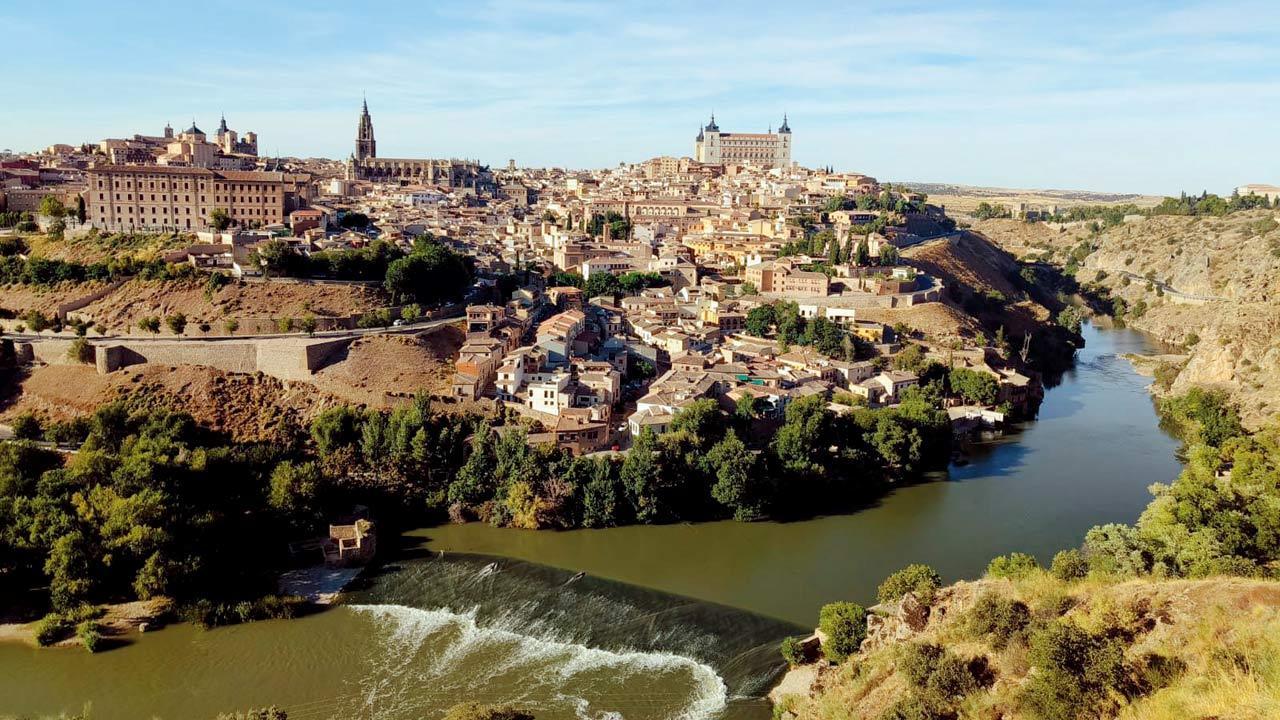
Toledo, the Imperial city and UNESCO World Heritage site fed by the Tagus River, is known for producing marzipan, a sweet treat made of ground almond, sugar and honey
Adventure
Tour & Taste
Relaxing
Educational
Ancient & Historical
ADVERTISEMENT
There's one particular moment during a hike in Serrania de Cuenca Natural Park, Castilla-La Mancha in Spain that Don Quixote, the 17th-century literary novel by Miguel de Cervantes, comes alive for me. As I trudge across limestone hills lush with pine trees and interjected by gorges and canyons, it is the realisation that the adventure really lies in setting out. As a student, I read the pages describing the misadventures of a rather whimsical knight gallivanting across the region of Castilla La Mancha in Spain. On this crispy afternoon under an unrelenting sun, I find myself on an imaginary exploration of the literary setting—not while reading on a couch, but on my two feet, matching step with a knight and his faithful squire Sancho Panzo.
Cervantes constructed his protagonist as a wanderer on a mission, without a clear destination but gifted with bizarre imagination. The region celebrates this story, and inspires travels around UNESCO villages, old towns, nature and food histories.
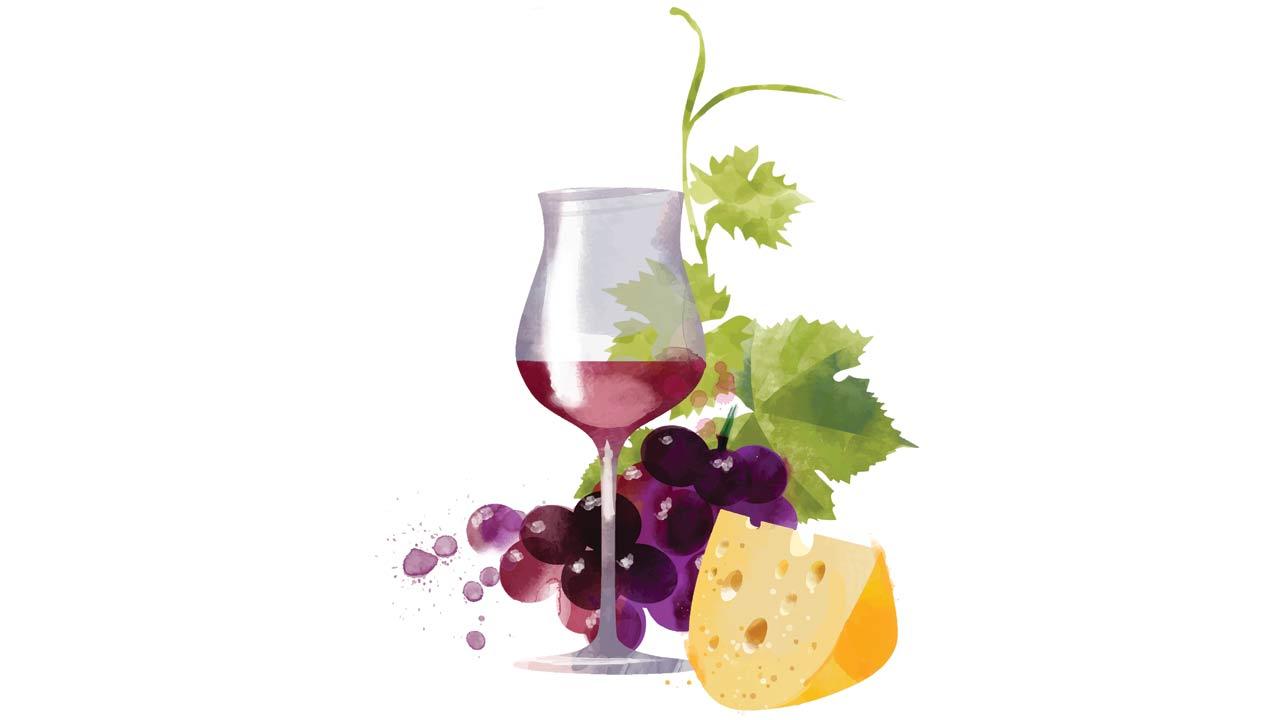 Pic/iStock
Pic/iStock
The natural park falls in the backyard of Cuenca, a 15th-century old town occupied by 2,000 residents. Here, one notices many firsts—houses hanging above the ravine overlooking the Huécar river, Spain’s first Gothic church, an aqueduct built during the Spanish War, and a parador (historical buildings converted into state-run luxury inns) the size of a football field.
Every year, from September 18-21, the town celebrates San Mateo festival—to mark the day Cuenca was formed. To kickstart the festivities, locals come together on the preluding Sunday for a cookout competition. Friends and families team up to cook Gachas, a high-caloric local winter delicacy made with pork, paprika, grasspea flour, and olive oil.
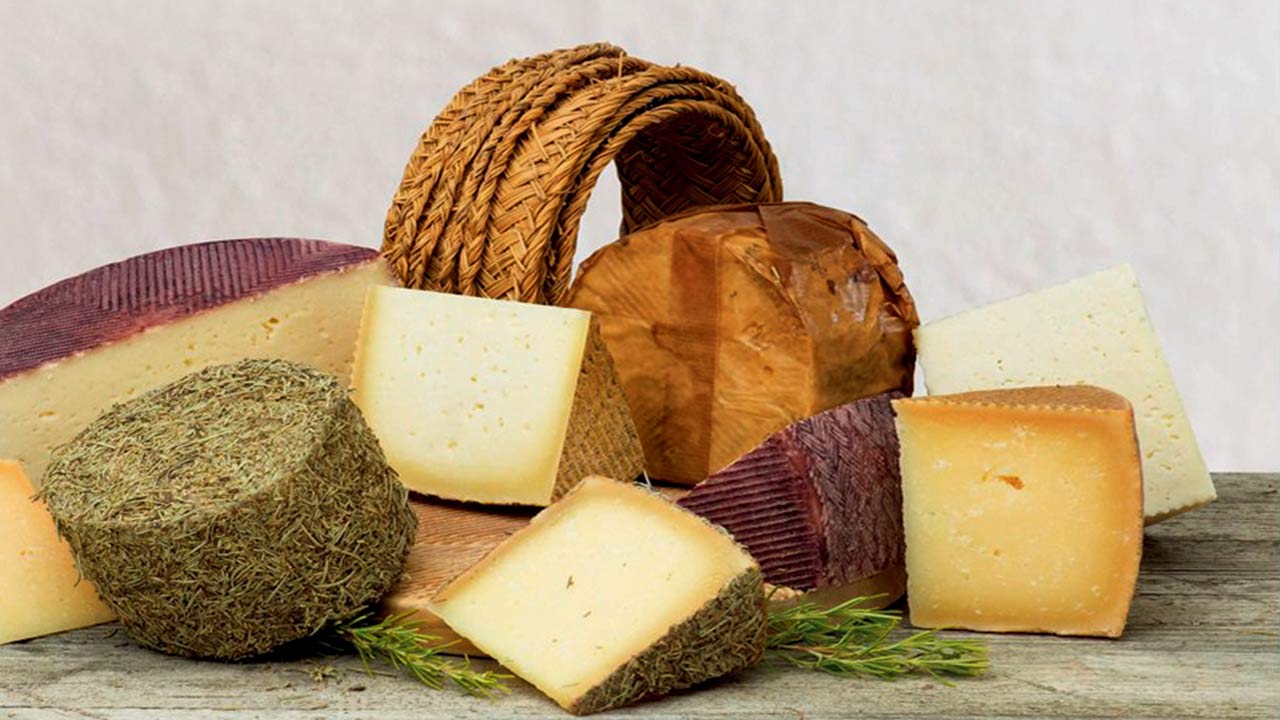 Assorted cheese from Villarejo cheese factory in La Mancha, Spain
Assorted cheese from Villarejo cheese factory in La Mancha, Spain
We’re in town the day of the competition and as our car drives into the venue, the sweet smell of pork fat mixed with smoke from makeshift charcoal grills welcomes us. It’s a grill party for the contenders, who have let their hair down and are biting on fried pork as the rural Iberian dish simmers in pots. The result is a pasty stew to be savoured with mushroom and potatoes. The real win, as it clearly shows, is a day out with friends over food and beer.
In the book, Don Quixote quotes, “You don’t live on bread alone.” Surely, he was a connoisseur of Manchego cheese. Next, on the Don Quixote trail is Villarejo Factory Manchego, an award-winning cheese factory in Villarejo de Fuentes. Since its inception in 1987, this cheese factory has won over 75 awards for its Manchego and La Mancha sheep cheese. A cheese council monitors the activity of cheese farmers in the region to keep up the quality of Protected Designation of Origin (PDO) for Queso (white) Manchego cheese.
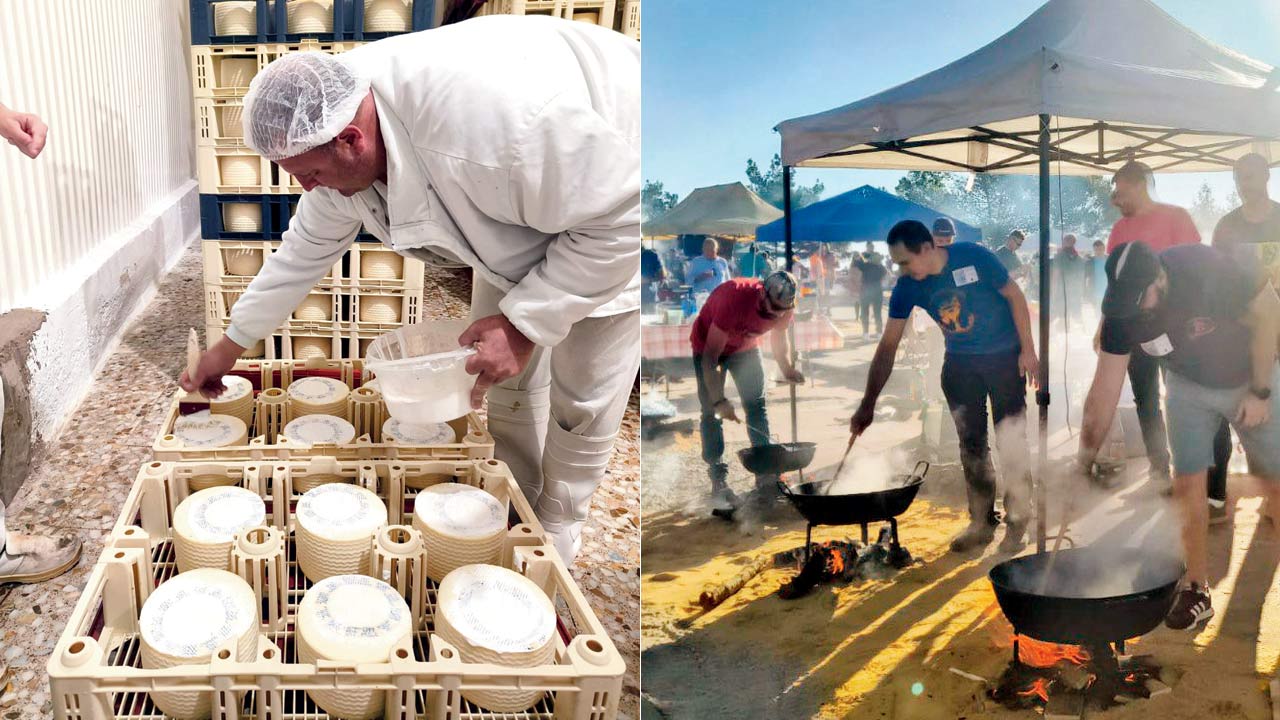 A cheese maker applies a coating of olive oil on the cheese rind; (right) Locals in Cuena take part in a Gachas competition to kickstart the San Mateo festival
A cheese maker applies a coating of olive oil on the cheese rind; (right) Locals in Cuena take part in a Gachas competition to kickstart the San Mateo festival
Our visit is a crash course in cheese making. We put on hair nets and capes, and step into a magical world where milk turns into cheese. “Manchego is made in the La Mancha region from the milk of sheep breed called Manchega,” third-generation owner Diego Alvarez Martínez explains.
The factory makes both Manchego as well as sheep cheese. The milk is sourced from across La Mancha, and transported to the factory in an isothermal tank truck. The first step of pasteurisation begins: “Cheese made from milk heated to 72 degrees for more than 15 seconds is considered pasteurised milk cheese; when heated at 66 degrees for more than 20 minutes, the cheese is categorised as raw milk cheese,” Diego tells us, adding, “When you pasteurise the milk, the higher heat kills some bacteria, but also kills flavour. Cheese made from raw milk gives better flavour.”
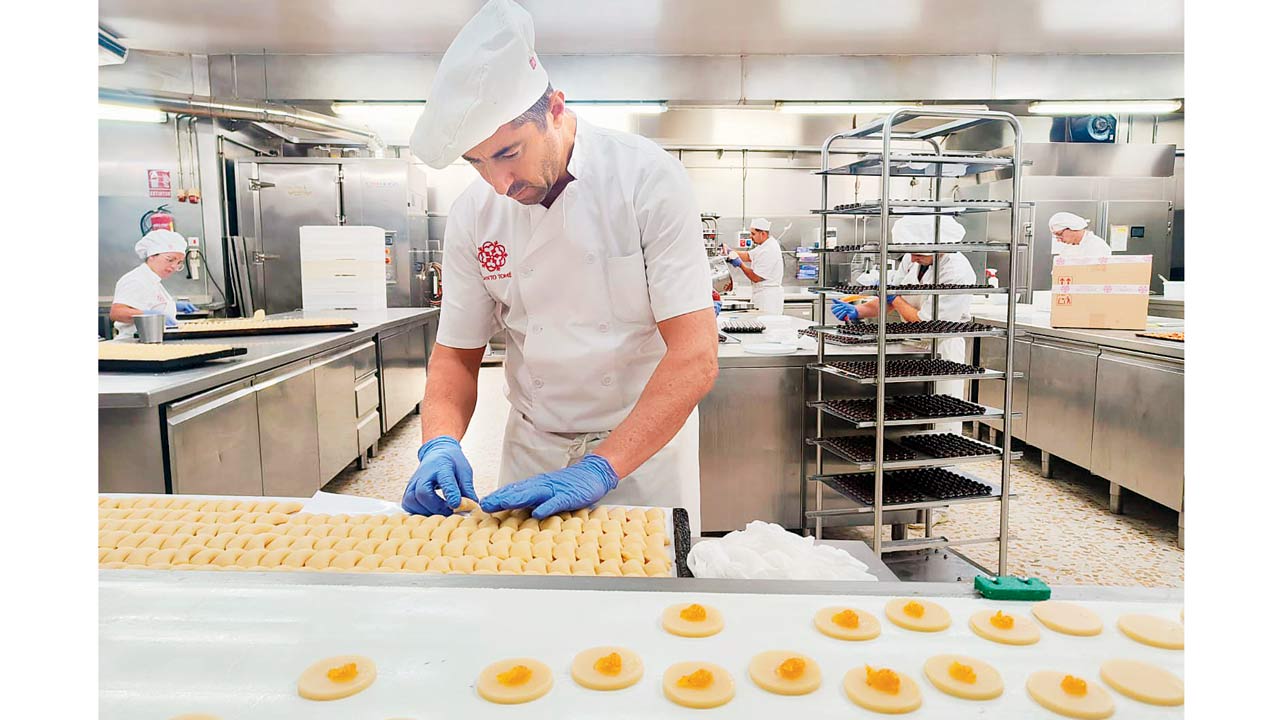
The milk, mixed with calcium chloride, lactic ferments, lysozyme (derived from eggs) and vegetable rennet, is churned by mechanised movements in a water bath for 30 to 60 minutes. The rennet curdles the milk and separates the whey. The curd is transferred into moulds with serrated bottoms, a common feature of authentic Manchego Cheese. The cheese is allowed to set for 30 minutes and then reversed in position with mechanised setup. This loses the serum and avoids holes in the cheese. This cheese is then submerged in a brine bath for 24 hours, after which it is stored in a chilled cave to mature. Every wheel gets is stamped ‘Queso Manchego PDO’ and serial numbers in five places; thus, every registered block can be traced by the Manchego PDO Council.
A cheese trick: Pair soft cheese with red wine, and strong cheese with white wine. “This way,” Diego tells us as we sit down to sample some wine and cheese pairings, “you can taste the cheese, and if you try the rind, you can taste the salt. Wine makers pass off bad wine with old cheese, as it kills the tannins in a bad wine.”
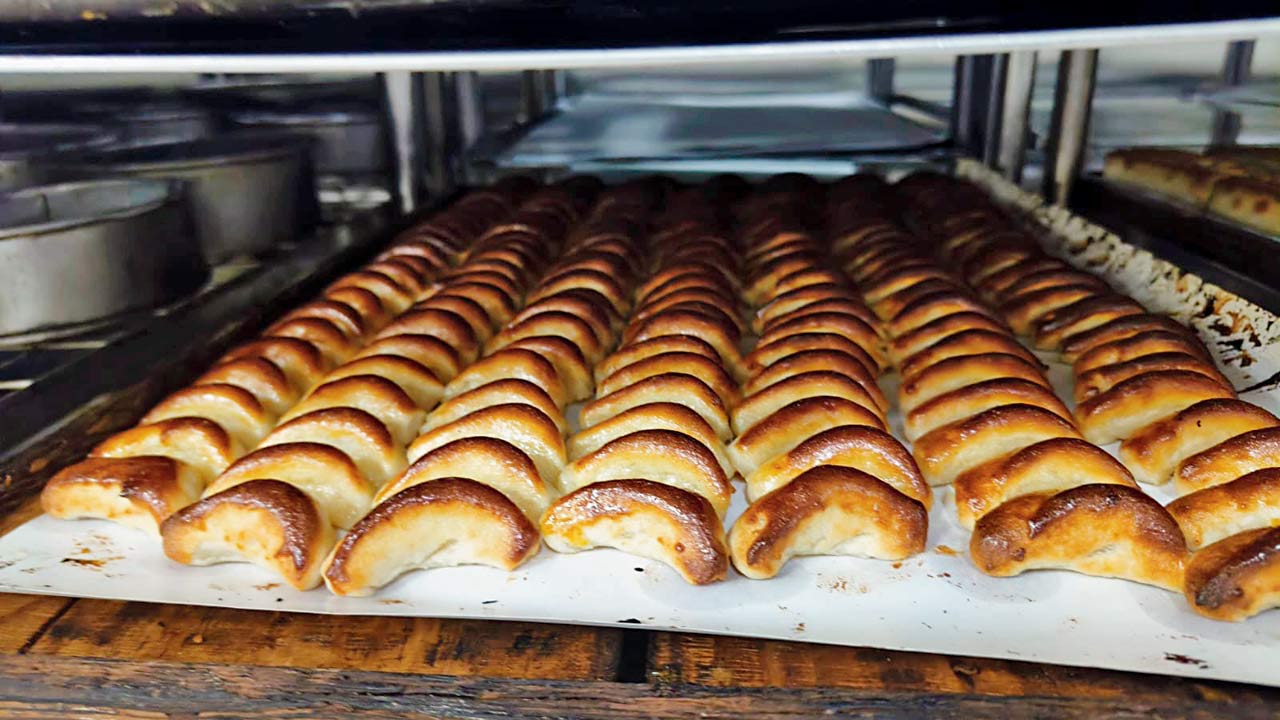 A worker readies trays of marzipan, coating them with egg before they are popped into the oven for three to four minutes
A worker readies trays of marzipan, coating them with egg before they are popped into the oven for three to four minutes
We try Manchego PDO semi-cured with three-months and six-months maturation; the flavour gets stronger and sharper with age. Sheep cheese, cured in rosemary with a seven months maturation, is herby and sharp. Manchego PDO cured cheese, made with raw milk, won the best artisanal cheese in the Grand Selection Awards in 2024. It is aromatic with a lingering pleasant aftertaste. Strong flavours with little flexibility, it breaks easily; the rind offers a sharp flavour. A standout sheep cheese, which won four international awards this year, is cured in honey and oil, and the rind is covered with oregano. It is a taste journey, through sweet honey, dense sheep cheese finished with the botanical notes of oregano. Take my word for it, there’s a place for all in cheese heaven.
After indulging in cheese and wine of La Mancha and gawking at windmills, Toledo, the Imperial city and UNESCO town fed by the Tagus River, welcomes us into its medieval charm—remnants of Jewish, Muslim and Christian architecture peppered with labyrinths, caves and mosques. It is nothing short of visual poetry.
Once the most important cities of Spain until Philip the Third decided to shift the capital to Madrid in 1561, its importance today is for a sweet reason—marzipan, made of ground almond, sugar and honey.
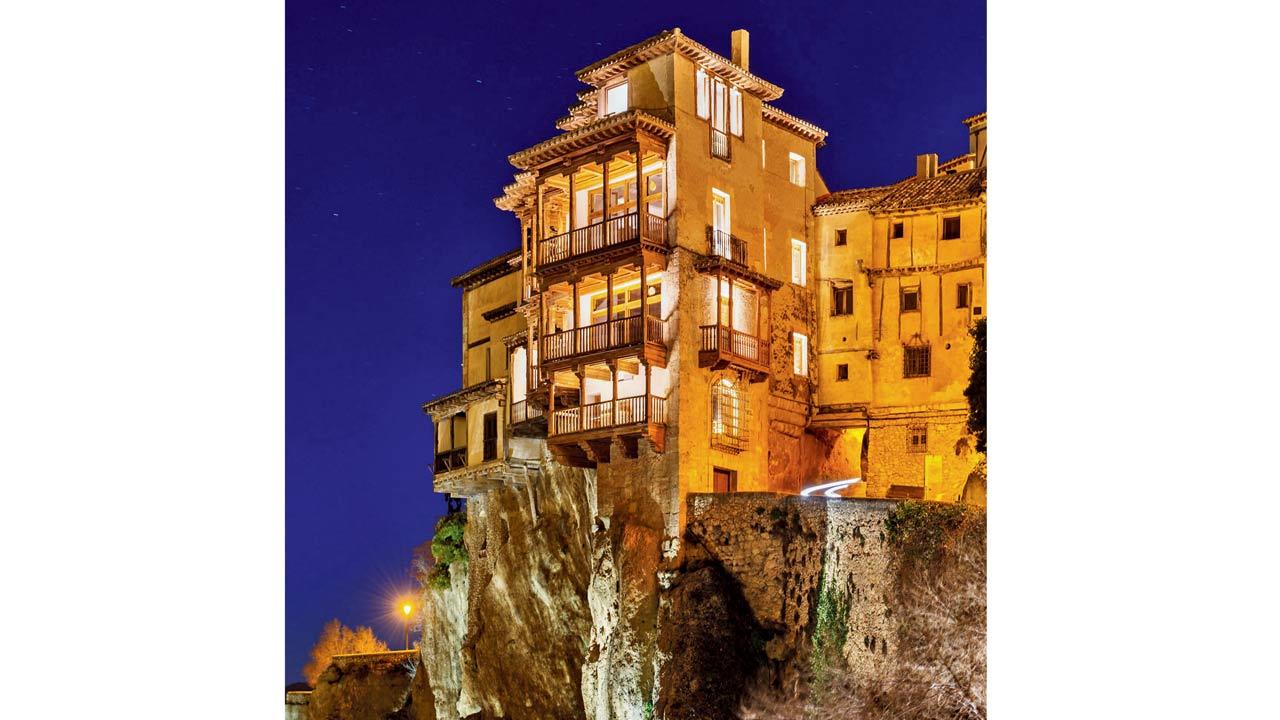 Out of 14, three hanging houses remain in Cuenca. They house a museum, restaurant and a government office respectively
Out of 14, three hanging houses remain in Cuenca. They house a museum, restaurant and a government office respectively
The history of marzipans in Spain stems from the influence of oriental cuisine. In 1212, during the reign of Alfonso Vlll, the term of mazapán was first used and then in the 15th century, it was administered to the sick to guise the taste of bitter medicines. In the Jewish Quarter of the Old Town stands Santo Tomé Bakery and Confectionery (Mazapan.in), one of the oldest marzipan makers since 1856. The smell of almond and sugar wafting from the kitchen is heady, spiking a sugar craving. Almonds are cleaned in water, mixed in sugar and honey and turned into a paste and left to sit for 24 hours before being stone ground into a mouldable paste. With a brush of egg yolk on top, wooden boards lined with marzipans are baked in the oven for three to four minutes.
When we enter, a team of chefs are at their stations. There are buckets of candied pumpkin prepared for Hair of Angel marzipan, Delicias or empanadas get a brush of egg before they are popped into the oven, and a variety of pine nut, almond and imperial pastries cool in trays. The special Anguila, or eel-shaped marzipan, is a work of art, while assorted marzipans are filled and with chocolate, strawberry, orange, lemon, apple, peach and apricots. We get a taste of a batch of Hair of Angel that have just finished cooling off on the trays—a sweet, grainy texture fills the mouth, bursting with the sugar rush, followed by nutty almond and at last the creamy egg yolk. While we are not sure whose cheese Don Quixote got his hands on, we’re happy the trail led us here.
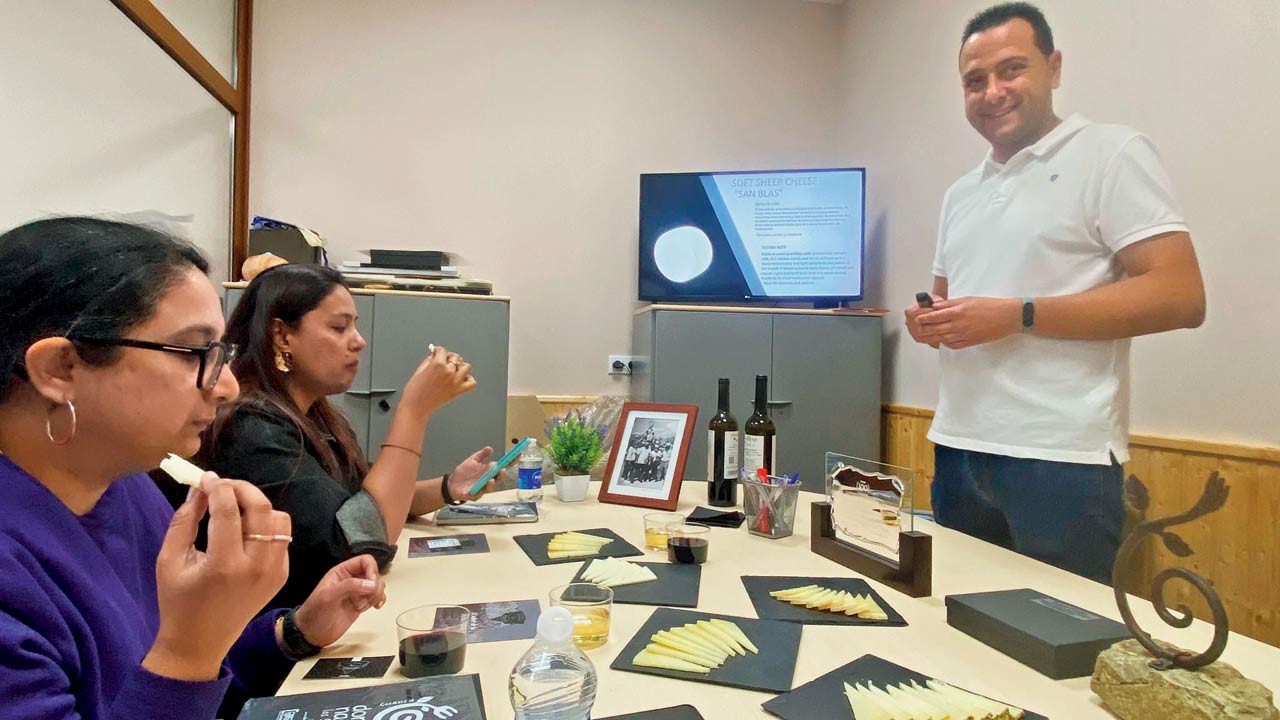 Phorum Pandya (extreme left) from Sunday mid-day attends a cheese and wine tasting conducted by Diego Alvarez Martínez of Villarejo Factory Manchego in Castilla La Mancha, Spain
Phorum Pandya (extreme left) from Sunday mid-day attends a cheese and wine tasting conducted by Diego Alvarez Martínez of Villarejo Factory Manchego in Castilla La Mancha, Spain
How to get there
Lufthansa (lufthansa.com) and Swiss Air (swiss.com) operate multiple layover flights from New Delhi and Mumbai to Madrid and Barcelona
Stay: Cuenca: Hotel Posada de San Jose www.psadadesanjose.com; Toledo: Hotel Carlos www.carlosv.com
Want to hear from you
We are looking to visit and write about interesting places of stay and travel, near and far. If you wish to host us for a fair, engaging experience review, write to us at smdmail@mid-day.com
 Subscribe today by clicking the link and stay updated with the latest news!" Click here!
Subscribe today by clicking the link and stay updated with the latest news!" Click here!







